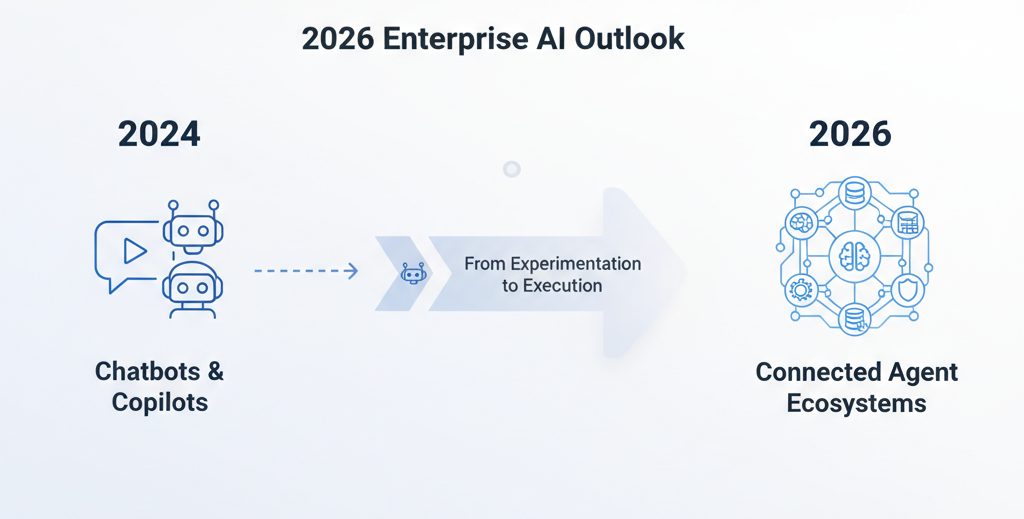Join our WhatsApp Community
AI-powered WhatsApp community for insights, support, and real-time collaboration.
Explore 2026’s enterprise AI transformation—where Agentic AI, governance, and small models redefine how businesses move from copilots to autonomous intelligence.
.png)
2025 was the year of experimentation; 2026 will be the year enterprises operationalize Agentic AI.
Expect tighter orchestration layers across CRM, ERP, and voice systems, lightweight private models tuned for context, and AI governance embedded as infrastructure.
The real differentiator won’t be model size — it’ll be how fast enterprises deploy trusted, auditable intelligence.
Fluid AI’s Agentic Platform is already bridging that gap — turning pilot projects into governed, production-grade systems that think and act.
| Why is AI important in the banking sector? | The shift from traditional in-person banking to online and mobile platforms has increased customer demand for instant, personalized service. |
| AI Virtual Assistants in Focus: | Banks are investing in AI-driven virtual assistants to create hyper-personalised, real-time solutions that improve customer experiences. |
| What is the top challenge of using AI in banking? | Inefficiencies like higher Average Handling Time (AHT), lack of real-time data, and limited personalization hinder existing customer service strategies. |
| Limits of Traditional Automation: | Automated systems need more nuanced queries, making them less effective for high-value customers with complex needs. |
| What are the benefits of AI chatbots in Banking? | AI virtual assistants enhance efficiency, reduce operational costs, and empower CSRs by handling repetitive tasks and offering personalized interactions. |
| Future Outlook of AI-enabled Virtual Assistants: | AI will transform the role of CSRs into more strategic, relationship-focused positions while continuing to elevate the customer experience in banking. |
Here’s the thing — every large enterprise has dabbled with AI by now.
Chatbots, copilots, GenAI proof-of-concepts… all useful, none transformative.
2026 changes that.
Executives are no longer asking “Can AI do this?” They’re asking “Can I trust AI to do this correctly, repeatedly, and compliantly?”
That’s where agentic orchestration comes in — a reasoning layer that connects data, decisions, and workflows across business systems.
Instead of manual hand-offs between analytics, CRMs, and ticketing tools, Agentic AI executes end-to-end actions with context and accountability.

👉 Learn more about Fluid AI’s orchestration layer that powers multi-channel intelligence.
The modern enterprise stack is being rebuilt around intelligence.
APIs connected systems; agents now coordinate them.
Governance isn’t a compliance afterthought anymore — it’s the core of technical architecture.
This model-govern-act feedback loop is how enterprise-grade Agentic AI scales safely.
📈 Infographic idea: “4-Layer Agentic AI Stack” — Knowledge → Model → Agentic → Governance loop.
For years, bigger meant better.
But 2026 belongs to small language models — lean, domain-focused systems outperforming massive LLMs within secure enterprise boundaries.
This shift prioritizes context over capacity.
Hybrid architectures will balance small, fast models for reasoning with large models for creativity.
That’s the essence of sovereign, private intelligence — controllable, compliant, and cost-efficient.
Fluid AI’s platform enables exactly this, combining scale and security through context-aware Agentic AI.
In 2026, AI governance becomes code, not policy.
Auditability and explainability are the new enterprise KPIs.
This convergence of IT, compliance, and business marks the era of governed intelligence — and platforms like Fluid AI are leading it through embedded governance frameworks.
.jpg)
The enterprise workforce is entering its AI collaboration era.
Copilots assist. Agents act.
Picture this:
A support email arrives. An AI agent reads it, fetches context, executes backend updates, and closes the case before sunrise.
That’s not futuristic — it’s today’s agentic workflow in real deployments.
Enterprises are already cutting integration complexity by 50% through unified orchestration — thanks to vendor simplification with Agentic AI.
To manage this new digital workforce, enterprises will need structured operating models.
Smart enterprises will treat agents like employees — accountable, auditable, and continuously improving.
Generic copilots are fading fast.
2026 will bring purpose-built agentic systems tailored for each industry.
Each vertical will rely on domain-specific reasoning agents tuned to its context and regulations — true Agentic AI for enterprises.
To prepare for this shift toward trusted autonomy, start small but structured.
Fluid AI follows this same “sandbox-to-scale” approach across industries using its customer support automation stack.
2026 won’t be about who has the biggest model — it’ll be about who builds trusted, autonomous systems first.
Agentic AI readiness is now the real differentiator.
Data, governance, and orchestration — that’s the new enterprise trinity.
Fluid AI’s Agentic Platform gives enterprises exactly that: governed, auditable autonomy that delivers measurable outcomes.
Because the future isn’t human versus AI.
It’s human + AI — thinking, deciding, and acting together.
Fluid AI is an AI company based in Mumbai. We help organizations kickstart their AI journey. If you’re seeking a solution for your organization to enhance customer support, boost employee productivity and make the most of your organization’s data, look no further.
Take the first step on this exciting journey by booking a Free Discovery Call with us today and let us help you make your organization future-ready and unlock the full potential of AI for your organization.

AI-powered WhatsApp community for insights, support, and real-time collaboration.
.webp)
.webp)

Join leading businesses using the
Agentic AI Platform to drive efficiency, innovation, and growth.
AI-powered WhatsApp community for insights, support, and real-time collaboration.